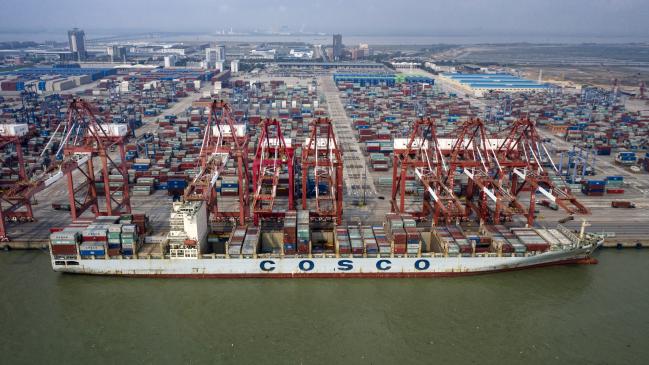(Bloomberg) -- The U.S. hiked tariffs on more than $200 billion in goods from China on Friday in the most dramatic step yet of Donald Trump’s push to extract trade concessions, deepening a conflict that has roiled financial markets and cast a shadow over the global economy.
China immediately said in a statement it is forced to retaliate, but didn’t specify how. The move came after discussions between Xi Jinping’s top trade envoy and his U.S. counterparts in Washington made little progress on Thursday, with the mood around them downbeat, according to people familiar with the talks. The negotiations were due to resume on Friday morning Washington time.
Ahead of the talks on Thursday, Trump also said the U.S. would go ahead with preparations to impose 25% tariffs on a further $325 billion in goods from China, raising the prospect of all of China’s goods exports to the U.S. -- which were worth about $540 billion last year -- being subject to new import duties.
Such a move would take weeks to deploy. But it would have significant repercussions for the U.S., Chinese and global economies. Economists at Moody’s Analytics said in a report this week that an all-out trade conflagration between the world’s two-largest economies risked tipping the U.S. economy into recession by the end of 2020 just as voters go to the polls in the U.S.
The new tariffs that took effect at 12:01 a.m. Washington time Friday raise from 10% to 25% the duties on more than 5,700 different product categories from China -- ranging from cooked vegetables to Christmas lights and highchairs for babies.
U.S. officials have said the new duties -- introduced on just five days’ notice -- will not apply to goods already on boats headed for American shores. A 25% tariff is already in place on a further $50 billion in imports from China.
Chinese Vice Premier Liu He huddled with U.S. Trade Representative Robert Lighthizer and Treasury Secretary Steven Mnuchin in Washington on Thursday for about 90 minutes of talks before breaking and reconvening later for a working dinner that broke up around 8:40 p.m. Washington time.
Though talks are set to resume Friday, some close observers said they were not hopeful for any meaningful breakthroughs. One person familiar with the discussions said that U.S. officials were unsure whether Liu had the authority to make any meaningful commitments. It was also unclear whether China had resolved the internal debates that had led to last week’s rescinding of prior commitments to enshrine reforms agreed in Chinese law.
Ahead of the talks, Liu told Chinese state media he was coming to Washington under pressure but “with sincerity” and warned that a move to raise tariffs by the U.S. starting Friday was not a solution and would be painful for both China and the U.S.
Earlier in the day, Trump calmed U.S. financial markets after he insisted it was still possible to reach a deal this week, even as he reiterated plans to raise tariffs on Chinese goods. Trump, speaking at an event in Washington, also said he may hold a phone call with his Chinese counterpart, Xi. No call between the two leaders had taken place by late Thursday nor had one been scheduled, according to a senior Trump administration official.
“He just wrote me a beautiful letter, I just received it, and I’ll probably speak to him by phone, but look, we have two great alternatives, our country is doing fantastically well,” Trump said. “Our alternative is an excellent one, it’s an alternative I’ve spoken about for years. We’ve taken well over $100 billion from China in a year.”
The escalation in the trade tensions between the U.S. and China has roiled financial markets around the world with investors who had been expecting a deal as recently as a week ago forced to confront a sharp turnaround in expectations. The S&P 500 retreated for a fourth day Thursday, falling into its worst stretch of losses this year.
What Bloomberg’s Economists Say
“A U.S. tariff hike on Chinese imports, should it materialize Friday, would hasten and broaden the policy easing cycle in Asia. Those central banks considering a shift to an easing bias would likely be a lot less hesitant in the event of higher tariff barriers.”Chang Shu, Chief Asia Economist at Bloomberg EconomicsFor the full note click here
China has disputed the U.S. characterization that the country reneged on prior commitments. But it has also sent its own signals that a deal could take time.
At the same time, Trump has seized on recent strong economic data as a sign that his trade wars are working and may even be boosting growth -- something economists challenge.
Trade data released Thursday showed the U.S. trade deficit with China decreased to the narrowest in almost three years as imports slowed and exports advanced. Strong gross domestic product and jobs numbers in recent weeks have also emboldened Trump.
“When people looked at the economic numbers, they were shocked. When they look at the import-export numbers they were shocked,” Trump said Thursday. “Try looking at all of the tariffs that China’s been paying us for the last eight months. Billions and billions of dollars.”
While Trump insists that the tariffs are paid for by China most economists say the evidence shows that their cost is being absorbed by American companies and consumers.
(Updates with China’s retaliation in second paragraph.)
